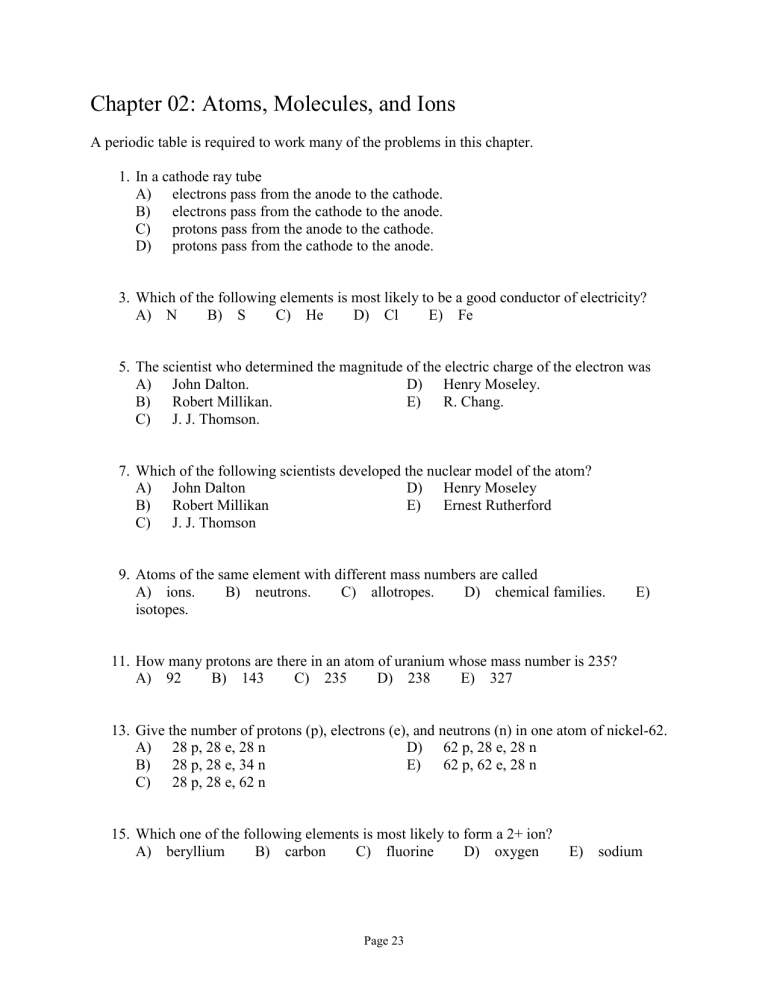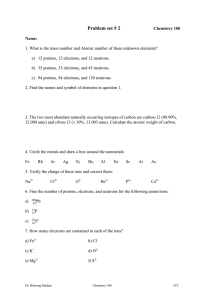
Chapter 02: Atoms, Molecules, and Ions A periodic table is required to work many of the problems in this chapter. 1. In a cathode ray tube A) electrons pass from the anode to the cathode. B) electrons pass from the cathode to the anode. C) protons pass from the anode to the cathode. D) protons pass from the cathode to the anode. 3. Which of the following elements is most likely to be a good conductor of electricity? A) N B) S C) He D) Cl E) Fe 5. The scientist who determined the magnitude of the electric charge of the electron was A) John Dalton. D) Henry Moseley. B) Robert Millikan. E) R. Chang. C) J. J. Thomson. 7. Which of the following scientists developed the nuclear model of the atom? A) John Dalton D) Henry Moseley B) Robert Millikan E) Ernest Rutherford C) J. J. Thomson 9. Atoms of the same element with different mass numbers are called A) ions. B) neutrons. C) allotropes. D) chemical families. isotopes. E) 11. How many protons are there in an atom of uranium whose mass number is 235? A) 92 B) 143 C) 235 D) 238 E) 327 13. Give the number of protons (p), electrons (e), and neutrons (n) in one atom of nickel-62. A) 28 p, 28 e, 28 n D) 62 p, 28 e, 28 n B) 28 p, 28 e, 34 n E) 62 p, 62 e, 28 n C) 28 p, 28 e, 62 n 15. Which one of the following elements is most likely to form a 2+ ion? A) beryllium B) carbon C) fluorine D) oxygen Page 23 E) sodium Chapter 02: Atoms, Molecules, and Ions 17. Two isotopes of an element differ in their A) symbol. B) atomic number. C) atomic mass. D) E) number of protons. number of electrons. 19. An aluminum ion, Al3+, has: A) 13 protons and 13 electrons B) 27 protons and 24 electrons C) 16 protons and 13 electrons D) E) 13 protons and 10 electrons 10 protons and 13 electrons 21. A phosphide ion has: A) 10 protons and 13 electrons B) 12 protons and 15 electrons C) 15 protons and 15 electrons D) E) 15 protons and 18 electrons 18 protons and 21 electrons 23. How many protons and electrons are present in one Br– ion? A) 35 p, 35 e D) 35 p, 36 e B) 80 p, 81 e E) 80 p, 34 e C) 35 p, 34 e 25. Which pair of elements would be most likely to form an ionic compound? A) P and Br B) Zn and K C) F and Al D) C and S E) Al and Rb 27. What is the formula for the ionic compound formed by calcium ions and nitrate ions? A) Ca3N2 B) Ca(NO3)2 C) Ca2NO3 D) Ca2NO2 E) CaNO3 29. What is the formula for the ionic compound formed by magnesium and iodine? A) MgI B) Mg2I C) MgI2 D) MgI3 E) Mg3I 31. Predict the formula for the binary compound formed between barium and phosphorus. A) BaP B) Ba2P C) BaP2 D) Ba2P3 E) Ba3P2 33. Which is the correct formula for copper(II) phosphate? A) Cu2PO4 B) Cu3(PO4)2 C) Cu2PO3 D) Cu(PO4)2 Page 24 E) Cu(PO3)2 Chapter 02: Atoms, Molecules, and Ions 35. The chemical name for ClO2– is chlorite ion. Therefore, the name of HClO2 is A) hydrochloric acid. D) chlorous acid. B) chloroform. E) chloric acid. C) hydrogen dioxychloride. 37. The formula for calcium phosphate is A) CaPO4. B) Ca3(PO4)2. C) Ca2(PO4)3. Ca3(PO3)2. 39. The formula for sodium sulfide is A) NaS. B) K2S. C) NaS2. D) Ca3P2. D) Na2S. E) E) SeS. 41. The correct name for Ba(OH)2 is A) barium hydrogen oxide. B) boron hydroxide. C) barium hydrate. D) E) beryllium hydroxide. barium hydroxide. 43. The correct name for CuSO4·5H2O is A) copper sulfate acid. B) copper sulfate pentahydrate. C) copper(II) sulfate acid. D) E) copper(II) sulfate pentahydrate. copper(V) sulfate hydrate. 45. The Stock system name for Mn2O7 is A) dimanganese heptaoxide. B) magnesium oxide. C) manganese(VII) oxide. D) E) manganese(II) oxide. manganese(III) oxide. 47. Consistent with vanadium being a transition metal, the name for VSO4 should be A) vanadium sulfide. D) vanadium (II) sulfate. B) vanadium (I) sulfite. E) vanadium sulfur tetraoxide. C) vanadium (I) sulfate. 49. The chemical formula for iron(II) nitrate is: A) Fe2(NO3)3 B) Ir(NO2)2 C) Fe2N3 Page 25 D) Fe(NO3)2 E) Fe(NO2)2 Chapter 02: Atoms, Molecules, and Ions 51. The Stock system name for CrO3 is: A) chromium oxide B) chromium(II) oxide C) chromium(III) trioxide D) E) chromium(III) oxide chromium(VI) oxide 53. The mineral pyrolusite is a compound of manganese-55 and oxygen-16. If 63% of the mass of pyrolusite is due to manganese, what is the empirical formula of pyrolusite? A) MnO B) Mn2O C) Mn2O2 D) MnO2 E) none of these 55. The mineral hausmannite is a compound of manganese-55 and oxygen-16. If 72% of the mass of hausmannite is due to manganese, what is the empirical formula of hausmannite? A) MnO B) Mn3O C) Mn3O4 D) Mn4O3 E) MnO3 57. The mineral orpiment, having the empirical formula As2S3, was used in ancient times as a cosmetic. What mass of arsenic is present in 5.0 g of orpiment? [Given: naturally occurring arsenic is all arsenic-75; assume that all naturally occurring sulfur is sulfur-32 (only approximately true)] A) 0.61 g B) 3.0 g C) 1.5 g D) 2.0 g E) 3.5 g 59. Which of the following elements is chemically similar to oxygen? A) sulfur B) calcium C) iron D) nickel E) sodium Page 26




